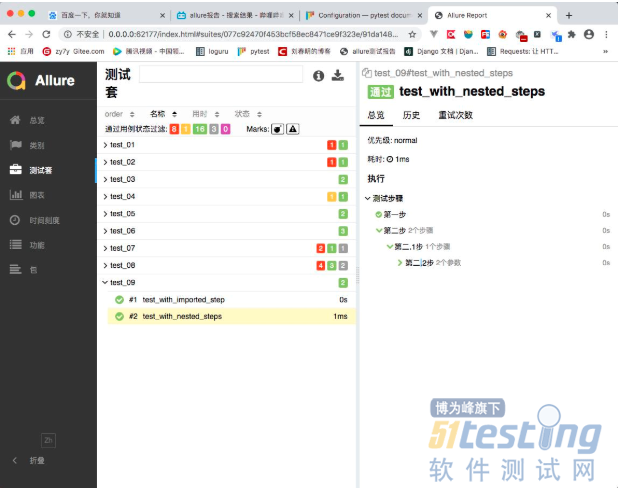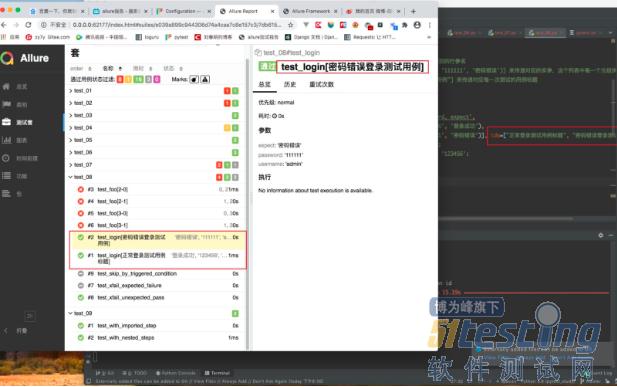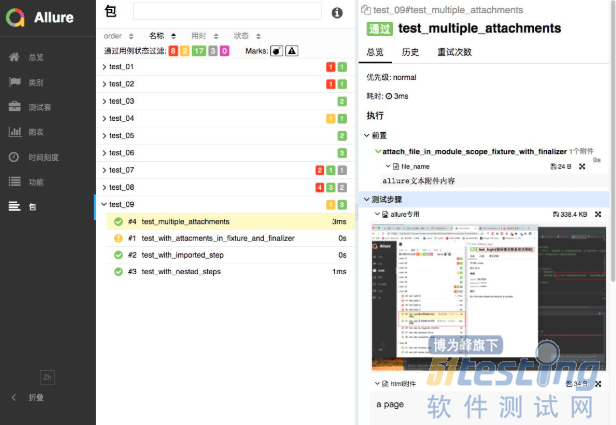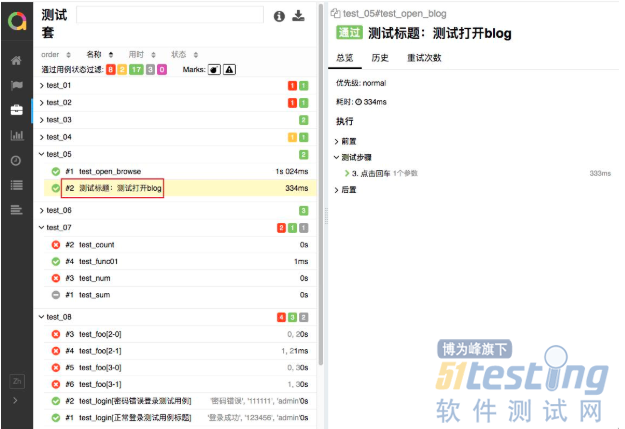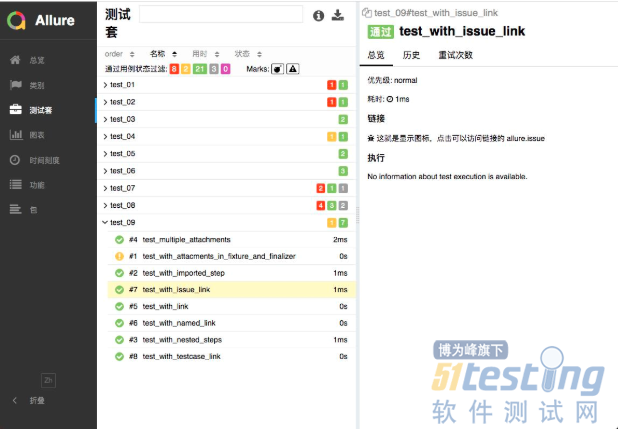pytest与allure中间的火花
1.安装配置allure:github.com/allure-fram…
下载后解压文件并添加到对应操作系统的环境变量中。
2.安装allure-pytest插件:pip install allure-pytest
3.添加allure测试结果报告存放路径pytest --alluredir=./report/allure_report_01(此方法会运行测试文件,并得到结果汇总到报告中,你还需执行下一步)。
5.生成测试报告(每次生成前清空测试报告目录):allure generate ./report/allure_report_01/ -o ./report01/ --clean
6.注意事项
如果直接执行pytest --alluredir=report,将会直接在当前目录下新建一个report的目录,并会运行pytest测试。
定制allure报告
1.给allure报告中的测试方法添加描述: 只需要在测试函数/方法下加上"""描述的内容"""
def test_sum(self):
""" 这部分内容将显示在 allure报告中"""
# assert进行断言
assert 1 == 2
2.测试步骤描述:在测试方法之前添加@allure.step('步骤描述')内容。
#!/usr/bin/env/python3
# -*- coding:utf-8 -*-
"""
@project: pytest_study
@author: zy7y
@file: test_09.py
@ide: PyCharm
@time: 2020/7/27
"""
import allure
import pytest
@allure.step('第一步')
def passing_step():
pass
@allure.step('第二步')
def step_with_nested_steps():
nested_step()
@allure.step('第二.1步')
def nested_step():
nested_step_with_arguments(1, 'abc')
@allure.step('第二.2步')
def nested_step_with_arguments(arg1, arg2):
pass
def test_with_imported_step():
passing_step()
def test_with_nested_steps():
passing_step()
step_with_nested_steps()
步骤可以有一个描述行,该描述行支持传递的位置参数和关键字参数的占位符。关键字参数的默认参数也将被捕获。
import allure
@allure.step('测试步骤标题中的占位符, 第一个参数: "{0}", 第二个参数keyword: "{key}"')
def step_with_title_placeholders(arg1, key=None):
pass
def test_steps_with_placeholders():
step_with_title_placeholders(1, key='something')
step_with_title_placeholders(2)
step_with_title_placeholders(3, 'anything')
3.ids测试用例标题: 每条用例ids关键字参数的内容将被填充到allure报告中。
@pytest.mark.parametrize('username, password, expect',
[('admin', '123456', '登录成功'),
('admin', '111111', '密码错误')], ids=["正常登录测试用例标题", "密码错误登录测试用例"])
def test_login(username, password, expect):
if username == 'admin' and password == '123456':
assert expect == '登录成功'
else:
assert expect == '密码错误'
4.向allure某个测试用例/函数/方法中添加附件:arllure.attcah(body, name, attachment_type, extension)或者添加本地附件allure.attach.file(source, name, attachment_type, extension)
· body - 需要写入的文件内容
· name - 文件名称
· attachment_type - 文件类型 allure.attachment_type
· extension - 文件后缀名
· source - 文件所在路径
import allure
import pytest
@pytest.fixture
def attach_file_in_module_scope_fixture_with_finalizer(request):
# 添加一个txt文件,文件名称为 file_name, 文件里面的内容为:allure文本附件内容
allure.attach('allure文本附件内容', 'file_name', allure.attachment_type.TEXT)
def test_multiple_attachments(attach_file_in_module_scope_fixture_with_finalizer):
# 本地上传一个图片文件给allure,
allure.attach.file('./Snipaste_2020-07-27_23-29-48.png', name='allure专用', attachment_type=allure.attachment_type.PNG)
allure.attach('<head></head><body> a page </body>', 'html附件', allure.attachment_type.HTML)
5.定制测试标题(测试函数在allure中的显示方式)内容:@allure.title()
@allure.title('测试标题:测试打开blog')
@allure.step('3. 点击回车')
def test_open_blog(browse_driver):
browse_driver.find_element_by_id('su').click()
#allure.dynamic.title('在成功完成测试后,标题被替换为这一行。')
6.添加链接:@allure.link或者@allure.issue或者@allure.testcase
# 显示链接
@allure.link('https://www.baidu.com/')
def test_with_link():
pass
@allure.link('https://www.youtube.com/watch?v=Su5p2TqZxKU', name='allure.link 实现的,传递了一个url,一个name')
def test_with_named_link():
pass
# 可以用来放禅道bug地址,它的图标是个虫子挺好的
@allure.issue('https://www.baidu.com', '这就是显示图标,点击可以访问链接的 allure.issue')
def test_with_issue_link():
pass
# 链接栏下方显示 测试用例标题, 点击实现跳转
@allure.testcase(TEST_CASE_LINK, '测试用例标题')
def test_with_testcase_link():
pass
7.按标签分组执行:@allure.feature and @allure.story
@allure.story('epic_1')
def test_with_epic_1():
pass
@allure.story('story_1')
def test_with_story_1():
pass
@allure.story('story_2')
def test_with_story_2():
pass
@allure.feature('feature_2')
@allure.story('story_2')
def test_with_story_2_and_feature_2():
pass
# pytest test_09.py --allure-stories story_1,story_2 只执行 含这两个标签的
# pytest test_09.py --allure-features feature2 --allure-stories story2
8.按严重度(优先级)分组执行:@allure.severity
# test.py
import allure
@allure.severity('blocker')
def test_with_no_severity_label():
pass
@allure.severity(allure.severity_level.TRIVIAL)
def test_with_trivial_severity():
pass
@allure.severity(allure.severity_level.NORMAL)
def test_with_normal_severity():
pass
@allure.severity(allure.severity_level.NORMAL)
class TestClassWithNormalSeverity(object):
def test_inside_the_normal_severity_test_class(self):
pass
@allure.severity(allure.severity_level.CRITICAL)
def test_inside_the_normal_severity_test_class_with_overriding_critical_severity(self):
pass
# 将执行严重性为NORML、CRITICAL的方法/类/函数
# pytest tests.py --allure-severities normal,critical
本文内容不用于商业目的,如涉及知识产权问题,请权利人联系51Testing小编(021-64471599-8017),我们将立即处理



